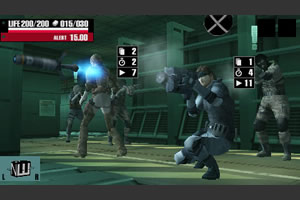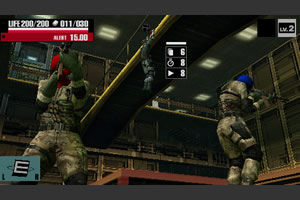Snake’s new deal.
True geeks know what it is to be the friend who listens. Sensitive, intelligent, beautiful girls come to us for meaningful talk and profound empathy, then go back to their idiot boyfriends for wild, monkey sex. We need to talk less and workout more, fellas.
In the meantime, though, we can get by with just our handhelds thanks to Konami’s surpassingly geeky and original Metal Gear Acid. Abandoning its stealth-action roots, Metal Gear Acid is a hard, awkward turn-based strategy game with enough depth to choke a python.
The story eschews the overblown meditations on life, loyalty and love that dominated the last Solid title in favor of themes more suited to a spy thriller: trust and identity. The tale begins when a plane carrying hundreds of passengers as well as a Presidential candidate is hijacked by two murderous dolls. The dolls claim to be the agents of a puppet-master and promise to kill everyone on board if a device known as Pythagoras isn’t delivered to their controller.
This is where Snake comes in. Pythagoras is being stored in a top-secret, jungle weapons lab that has just been overrun by mercenaries. After infiltrating the lab, Snake meets up with a SWAT agent named Teliko, and the two of them embark on a surreal quest to unravel the mysteries of…well, everything. Metal Gear Acid‘s plot is full of fascinating twists and provides food for thought while keeping the series’ high flown diatribes to a minimum.
Too bad the dialogue is some of the worst ever written. Most of the conversations are between Snake and Roger, his commanding CIA officer, who might be clinically retarded. At one point, a suspicious fellow named Gary tells Snake that what he seeks is hidden in a particular room in a barracks. On the threshold, Snake calls Roger:
Snake: Roger, I'm here, but I think it's a trap. Roger: Gary said to go in that room, Snake. Snake: Yeah, but can we trust him? Roger: We won't know until you go in there, Snake, so get a move on! Snake: I see your point, Roger. I'm going in.
Excellent plan – let’s find out if it’s a trap by walking into the trap. It’s so stupid, it just might work.
Normally I wouldn’t make such a big deal out of bad dialogue, but Metal Gear Acid‘s is so amateurish, silly and pervasive that it spoils what is otherwise a pretty cool plot. You won’t care that Roger may not be what he seems because he is clearly an idiot. The dolls, meant to be disturbingly psychopathic, are painfully juvenile and predictable. Where the Metal Gear Solid games tried too hard to be taken seriously, Metal Gear Acid doesn’t try hard enough.
For all the awful dialogue, there is amazingly little explanation of how you’re actually supposed to play. Metal Gear Acid is a seriously opaque, unintuitive game, and instead of having someone sensible walk you through all the steps and explain in-game what everything means and how it all works, the task is left to Roger, the mental midget. Not only does he brush over important mechanics in terms you aren’t likely to understand, he actually misinforms you.
But we will not. Metal Gear Acid is a turn-based strategy game facilitated by a trading card system. Instead of running Snake around in real-time, you can make him perform a limited number of actions, each of which uses a card, and you can only use a set number of cards per turn.
 The amount of time between turns is determined by the cost of your actions. For example, moving costs very little, but popping a scope on your sniper rifle and blasting an enemy costs a lot, meaning you will have to wait longer before you can move again. Card cost is found on the upper right-hand corner of every card. It’s pretty straightforward, but nine hours into the game and I still didn’t really know how it worked thanks to Roger’s terrible explanation.
The amount of time between turns is determined by the cost of your actions. For example, moving costs very little, but popping a scope on your sniper rifle and blasting an enemy costs a lot, meaning you will have to wait longer before you can move again. Card cost is found on the upper right-hand corner of every card. It’s pretty straightforward, but nine hours into the game and I still didn’t really know how it worked thanks to Roger’s terrible explanation.
Even worse was his briefing on weapons. Some guns, like the SOCOM and FAMAS, can simply be used whenever they show up in your hand. Others, like the AK-47, have to be equipped. Since the AK uses 5.45 mm rounds, you can’t use it until you have another gun card in your hand that also uses 5.45 mm rounds, at which point you may equip that weapon on top of the AK, which somehow loads it. Then you may fire. But instead of telling you all this, Roger keeps going on about applying bullet cards to your guns. What you’ll fail to realize is that gun cards used in loading other gun cards are considered bullet cards. Of course. Did we mention that Metal Gear Acid was also a PSP?
Suffice it to say, Metal Gear Acid is tough to figure out and even tougher to get into. You’ll spend your first three hours fumbling through maps with no idea how to play. However, once you break the surface, you’ll discover a pleasantly deep, rewarding strategy game that fits well within the framework established by previous Metal Gears. The action is definitely slower and there’s zero twitch-factor, but that’s the nature of turn-based strategy.
Snake can still flatten against walls, knock to lure enemies, fire Nikita missiles, and eat rations to regain health. The only thing he can’t do is sneak up behind his foes and grab them, and we aren’t really sure why. Instead, Snake can punch, doing minimal damage but knocking enemies down, leaving them vulnerable to greater damage from weapons. While grabbing enemies is a sadly missing staple, Metal Gear Acid adds so much depth to the series that it seems wrong to complain about this one omission. Besides, there are plenty of other things genuinely worth griping about.
The card system is not one of them, however. Snake and Teliko can only have about thirty cards in their respective decks during a mission, but they will accumulate literally hundreds over the course of the game. Cards are usually purchased in between levels with credits you earn for completing missions, although some can be found in the levels themselves. Thanks to the sheer number of cards, the possible deck variations are far too numerous to count without a mathematical system, meaning you can approach each level in countless different ways for a myriad of different play experiences. Any level you beat can be replayed with additional challenges, giving Metal Gear Acid tons of replay value.
At least, until you get sick of the underwhelming enemy A.I. Even though your foes are well equipped, they behave like individual units instead of pursuing you as a squad. They frequently end up bottle-necking in hallways and doorways, so killing a squad of four soldiers is usually as simple as one Nikita missile or well-timed grenade.
The main challenge lies in sneaking past patrols. However, this has been hampered by the fact that enemies only move when you are near them, making it impossible to predict how they will act until you are in too deep to withdraw. Maybe this was a measure implemented to save time or memory, but it makes stealth movement without using a “Box A” or something almost impossible.
 Metal Gear Acid‘s awful camera can also mar your attempts at subtlety. Normally centered on your active character, the camera can be rotated 360 degrees and tilted with the analog stick. You can also push a button to move the camera around freely, except that when you do this, the camera pulls back and cannot be zoomed in. As a result, inspecting multi-tiered environments is nearly impossible because the upper levels get in your way. A first-person perspective would have been extremely helpful.
Metal Gear Acid‘s awful camera can also mar your attempts at subtlety. Normally centered on your active character, the camera can be rotated 360 degrees and tilted with the analog stick. You can also push a button to move the camera around freely, except that when you do this, the camera pulls back and cannot be zoomed in. As a result, inspecting multi-tiered environments is nearly impossible because the upper levels get in your way. A first-person perspective would have been extremely helpful.
Metal Gear Acid‘s presentation is far worse than what you’re used to from the PS2 Metal Gear titles…and from other PSP games, for that matter. The game is roughest when you’re inside and enemies are taking turns outside, because everything other than the room you’re currently in is rendered as an olive-green field, presumably to save memory. So when enemies move, all you see are their statistical tags shifting around in a lifeless, green plane. It’s also common to be brutalized by slowdown when a few units are onscreen at once, a weird issue considering this is a turn-based game. Snake’s character seems to be made of fewer polygons than usual, although Teliko looks excellent and the series’ wonderful CGI cut-scenes have been replaced by cool comic-book style images.
The music and sound effects are still intact, giving Metal Gear Acid some much needed Metal Gear flavor, but voice-acting has been left out entirely, meaning you will have to scroll through line after line of crappy written dialogue. Fortunately, you can press Start to skip any cut-scenes or hold three buttons to cycle through dialogue at an ultra high-speed.
Since Metal Gear Acid essentially follows the exploits of Snake and Teliko, co-operative multiplayer would seem like a no-brainer. It would also seem natural to make the game playable on the Internet via Infrastructure mode, since lag doesn’t really interfere with turn-based gameplay. Instead, the only wi-fi option is a strange Versus game that must be played Ad Hoc (locally). Still, Metal Gear Acid‘s single player takes +20 hours to beat and is replayable, so there’s plenty of offline game for your buck.
Although Metal Gear Acid may not be the game to show off your PSP’s graphical prowess, it is probably the deepest title available for the new system. It’s also a very original title – you don’t see too many turn-based stealth/strategy games, and we respect the fact that Konami took a big risk with their flagship franchise in an attempt to deliver a true PSP-only game. The result is somewhat flawed and definitely not for kids or casual gamers, especially due to the Mature rating, making Metal Gear Acid a game of geeks, by geeks, and for geeks. Whether or not you fall into that camp is between you and your hot girl “friend.”
-
Cool card system
-
Deep and smart
-
Highly playable
-
Highly frustrating
-
Terrible camera
-
Bad A.I.









